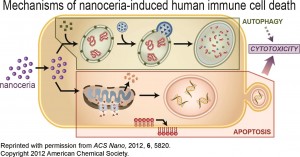Nanomaterials have shown such great potential to advance science and engineering that sometimes research on their applications can skip ahead of safety tests.
Nanoceria, a commonly used nanomaterial, is one such substance. These fine grains of cerium oxide have been proposed for use in fuels, sunscreens, and even pharmaceutical treatments, but the effects of long-term exposure have not been comprehensively investigated. Now, in a critical review published in Environmental Science: Nano’s themed issue, a team of pharmacists and environmental chemists have compiled and analyzed the available research on nanoceria’s health effects.
Nanoceria appears to have minimal effects when applied to the skin, and is not absorbed into the body through the digestive tract. However, once it makes its way into the bloodstream, whether through inhalation or direct injection, it can travel throughout the body.
Nanoceria is biopersistent, meaning that it does not dissolve or break down in the body, but instead builds up. When it finds its way into certain organs—such as the lungs or the liver—it can take months to completely leave, and can lead to inflammation and abnormal tissue growth. As with many hazardous materials, the risks are greater with higher doses or longer-term exposure.
The researchers propose that nanoceria’s toxic effects occur through inducing oxidative stress, an imbalance between oxidizing molecules and antioxidants that can disrupt biochemical pathways in the body. Because the surface properties of nanomaterials are believed to have the greatest influence on their potential toxicity, the authors suggest that coating the particles with a biologically inert material or altering their surface structure could reduce their impacts.
Nanoceria should not be indiscriminately avoided based on these findings—and some research has found positive biological applications for the substance, and even essential chemicals like water can be toxic in high enough doses. Rather, scientists working with these particles should understand their potential risks and work to minimize them.
To access the full article, download a copy for free* by clicking the link below.
The yin: an adverse health perspective of nanoceria: uptake, distribution, accumulation, and mechanisms of its toxicity
DOI: 10.1039/c4en00039k
R. Yokel et al.
Liked this blog? Find out more about Laurel in her first Environmental Science: Nano blog on rare earth elements.
*Access is free through a registered RSC account – click here to register











